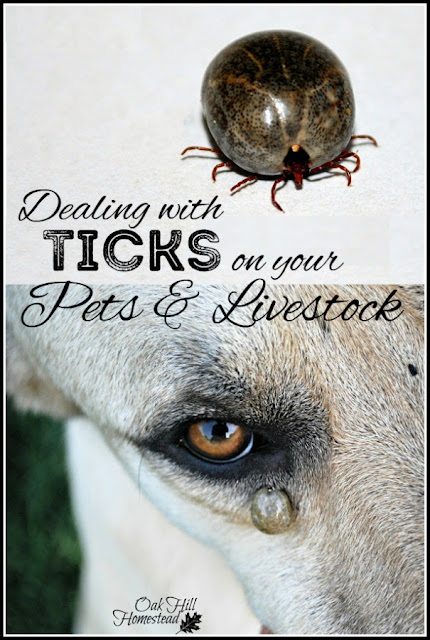After that we were tick-free for many years until we moved to Oklahoma. We live waaay out in the country with tall vegetation, and are surrounded by woods. One day, shortly after moving here, we found a tick on one of our barn cats. I removed it so very carefully with tweezers and applied alcohol to the bite while our daughter held the cat. As that summer went on, I had to deal with ticks nearly every day. Now, ten years later, I just pull them off with my fingernails and dunk them in water to drown them (the little ones) or step on them (the big ones make a very satisfying POP when stepped on). Ticks disgust me, but they have to be dealt with and I usually don't have time to be fussy about it or to find the tweezers.
The barn cats rarely have ticks anymore - I think it's because the horses have the run of the barnyard and keep the grass low - but our wandering dog Cracker, oh my. I give him the "once over" every day and he loves the attention. I don't find a tick on him every day, but sometimes I find half a dozen. Even the little ones are easy to feel in his short plush coat. And how about this big fat one:
The CDC lists 14 diseases that can be transmitted by ticks to animals and humans alike. We lost Cracker's predecessor to tick fever. The diseases ticks carry have changed some peoples' lives dramatically, so they aren't something to mess around with. In June 2014 Oklahoma reported its first case of and first death from the Heartland Virus, a new tick-borne disease in the state. Fortunately, the CDC says a tick usually has to be embedded for at least 36-48 hours to infect a human.
Planting flea and tick-repellent plants in your yard might help keep the ticks down as well. Lavender, lemongrass, sage, catnip and other mints are supposed to be effective. Keep the grass mowed short during tick season as well.
We bought a tub of garlic pellets intended to be fed to the horses with their grain daily, to repel ticks, flies, and mosquitoes. The horses refused to eat their garlic-laced feed, so that was a fail. (I probably should have started with a small amount and worked up to the recommended daily dose.)
As a goat lover and a homestead gardener, I'm excited to also share my gardening tips with you - from planting seeds to enjoying the fruits (and vegetables) of your labor! You can find my gardening advice and insights right here, so let's dig in and cultivate some fresh, delicious produce together.
Preventic® tick collars are effective for dogs, but Cracker loses them regularly so I can't depend on them. Science Daily recently wrote that scientists in New Jersey are reporting "discovery and successful tests of the first once-a-month pill for controlling both fleas and ticks in domestic dogs and cats." I strive to live as organically as possible, but I'll be watching for updates on this product.
My current defense against ticks is diatomaceous earth, rubbed into the animal's coat. Be sure to use food grade DE, not pool grade, and avoid breathing in the powder because it's hard on your lungs. DE works by piercing the exoskeleton of insects so that they dry out and die. Putting DE in a shaker jar makes it easy to sprinkle on the animal. Years ago I used Hi Yield livestock powder in the same way.
My thanks go to my dog Cracker for standing still (sort of) while I took that picture and then pulled the tick off his face, and to hubby's dog Sissy for finding the engorged one on the floor IN THE HOUSE so I could photograph it. I know, those photos creep me out too.
Do you live in an area where ticks are prevalent? Do you have problems with ticks on your livestock? How do you prevent tick bites?
Related websites (you will navigate away from Oak Hill Homestead)
Whole Fed Homestead - tips on natural tick prevention.
An illustrated guide to tick removal
How to Remove a Tick
National Alliance of Safe Pest Control

















